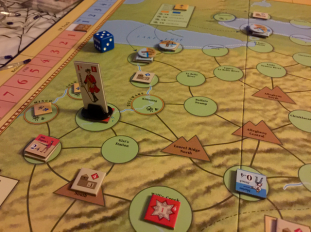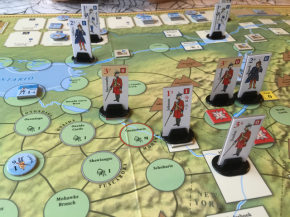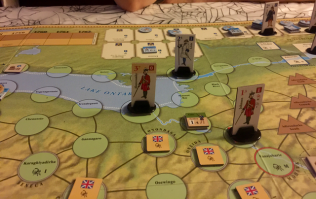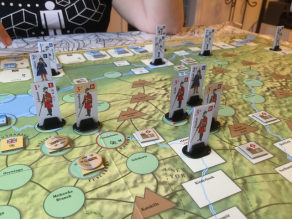As I mentioned previously, I did come by with the third edition reprint of Wilderness War and had to give it a go. System is not terribly complicated and while some minor mistakes(?) were made in the game it became somewhat familiar – quite simple system really but more about that later. Unfortunately not too many photos were taken from the whole, but it turned out to be rather interesting outing.
My opponent decided to pick the French, albeit I did point out that British may be easier, in a more straight forward way, while French required some rather wicked thinking. As I picked the British, there was one matter very clear from the beginning – lack of the auxiliaries is really big. I thought of fighting the French in the Ohio Forks, and build my own version of Forbes road there under the command of Bradstreet. It was very long process, and went all the way to fourth hand before I did manage to reduce the fortification and road further north was open. French on the other hand, tried to fight everywhere that British were not.
Wolfe appeared in good time to Halifax and prospect of amphibious landing on Louisbourg looked promising (except of Coehorns, I had all the cards, and even extra reinforcements). So, spending cards to activate Wolfe, amphibious landing only to realize that French decided to fight with their army that was still present. Of course, since Wolfe had numerical superiority, he thought that it won’t matter, but found it much harder to land in the beach than imagined, and promptly retreated (next time I know that numerical superiority is not enough – it has to be overwhelming superiority). Because of the losses, and lack of resources, landing was not attempted again and Wolfe altered his plans for enjoyable Halifax beach holiday instead of one filled with flying lead.
When British prepared what was to be known as the great Louisbourg blunder, and while Montcalm found his forces reduced by small pox in Montreal, French busy little beaver build fortifications to Oswego and Cataraqui. This pretty much made sure that no force could have easy access through that route (interesting that these two points happened to be rather important in the real war as well – and lack of fortification in Cataraqui allowed Rogers Rangers to raid the location and effectually cut the supply route).
Johnson was the first to realize that when he attempted to siege Oswego, and the garrison was relieved by force led by Lewis (ordeal was a huge risk for French due insufficient retreat spaces, but paid off). It was dear defeat to British, and it took some time before Abercromby arrived to deal with the opposition. He, as the Commander in Chief, already advancing through the region decided that it is through the Oneida Carry down to Lake Ontario, and then to Montreal or nothing. French stood firm at Oswego but finally gave up with Surrender.
For British it appears quite important to clear the French forts from various locations to make logistics to work – without it, there is no advance, no sieges etc. That process cost big deal of resources, additional to the cumbersome advance of the British generals. First, advance into the position, then play usually two or more cards to siege and finally one to assault. British subjective numerical superiority does not really help if the forces cannot be concentrated under functional command. Not having proper auxiliary support only makes things even harder – every insufficiently equipped regular army that fell victim to French only granted more VP’s. Additionally, every regular British army was in constant risk of ambush that would turn otherwise favorable odds against them.
French of course made colonial life hard in the southern department and raiding repeatedly some settlements, and eventually at the first round count had pocketed two VP’s. They could have done much more if elected to use other auxiliaries more efficiently. Colonials did not much appreciate the British efforts and albeit previously enthusiastic with their support withdrew eventually and became reluctant to give anymore. So, south became additional drain for resources that could have been used elsewhere… Only good thing was that both southern and northern departments had militia in place.
After losing two forts (an afterthought, both should have considered demolishing the some forts and stockades instead of letting them fall to opponents hands), French morale crumbled somewhat, but nevertheless, VP track was +1 for French, and there were only two hands to go. British assault was stalled in almost every corner, and while some indians swore allegiance, and few rangers brought some relief to British, it would be rather hard to move the offensive anywhere. Considering that French had their positions quite solidly protected and realizing that British had no way to move any of the 3 commanders on one but last had, and no way to get Louisbourg plunder resolved due to lack of amphibious landing, British called it a day.
There were probably some activities that I could have done, if not to push to Montreal, Niagara was definitely within reach. However, game took a bit longer than expected and it was getting a tad late. I can definitely see why Wilderness War produces really close and tense games.




